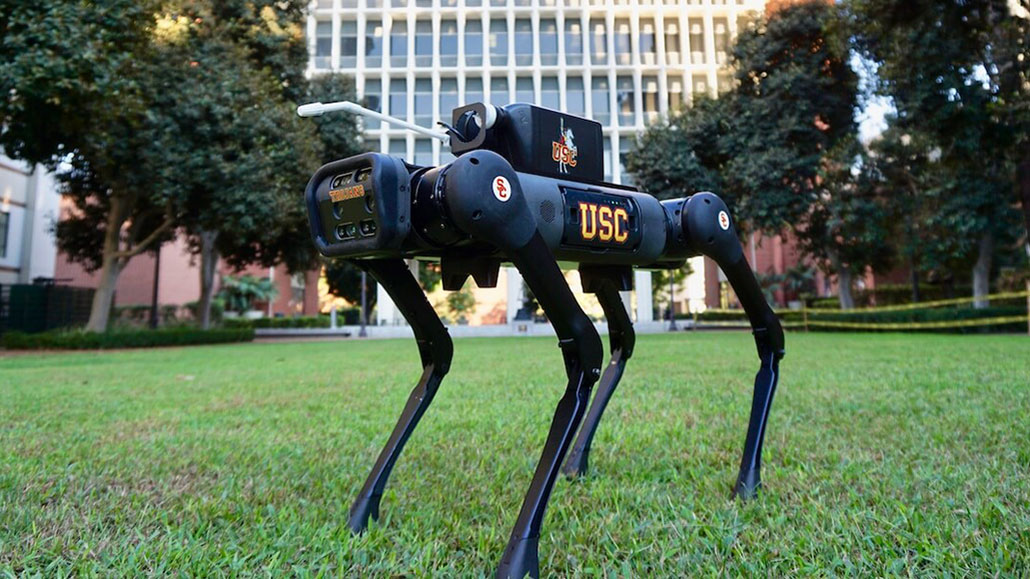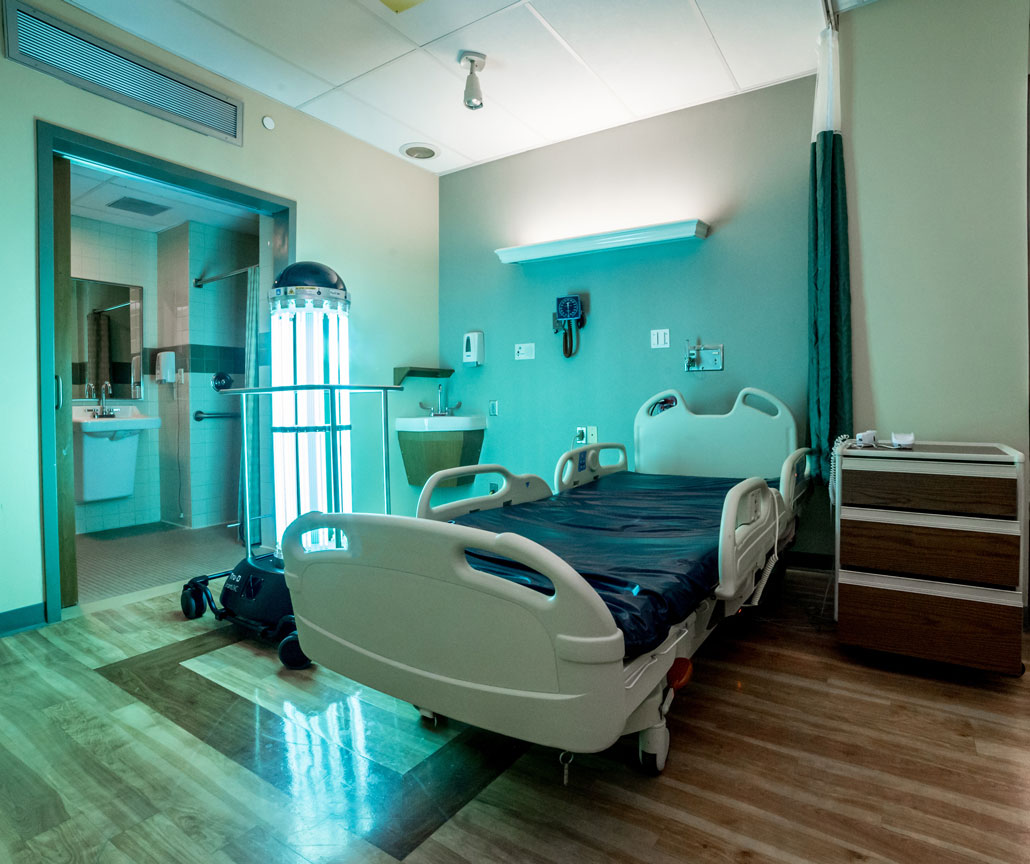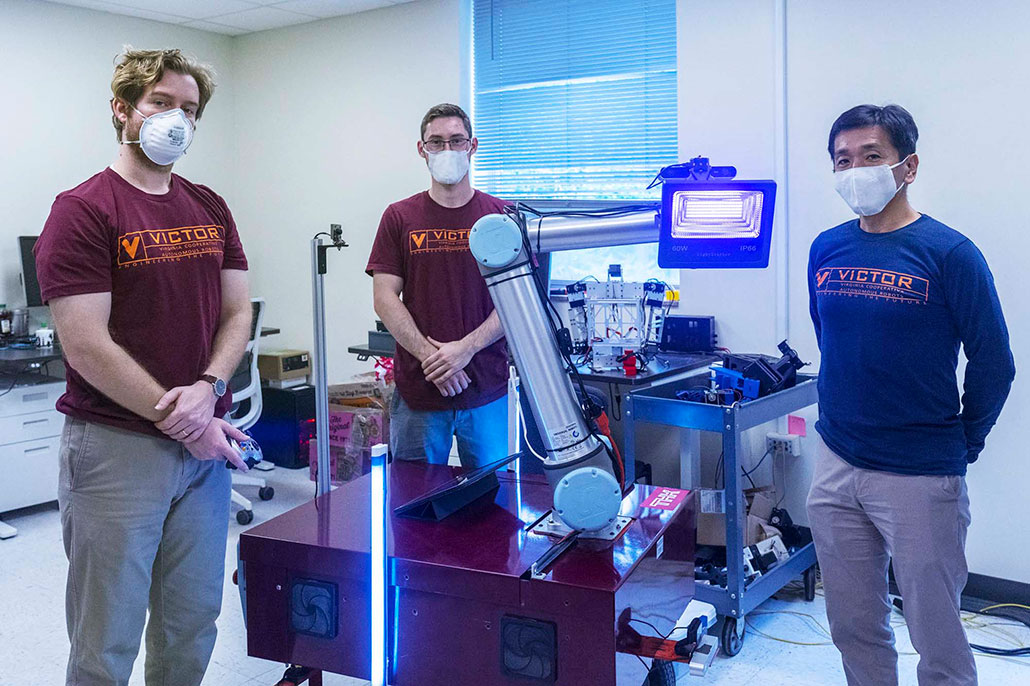New robots can clean virus-laden surfaces so people won’t have to
Pandemic-inspired cleaning machines — some of which even walk — are under development

This robot looks a bit like a dog or cat as it stretches and crouches to spray a germ-fighting cleaner onto surfaces. Such novel automatons can help stop the spread of COVID-19 and other diseases.
Quan Nguyen
A robot prances on four slender legs. It almost appears to be dancing. Then it stops in front of a chair in an empty auditorium. Suddenly, a mist spews from a nozzle atop its head. The sci-fi-like machine now twists itself to the left, then to the right, then up and down. That mist is a poison — at least if you’re a germ. And the robot is using it to disinfect the entire chair. When done, the nimble robot will move on to the next one.
Named LASER-D, “It’s basically a robot dog,” explains Yiyu Chen, one of its designers. He’s a graduate student in Los Angeles at the University of Southern California’s Viterbi School of Engineering. There, his team has tested LASER-D in classrooms, laboratories — even outdoors. Their mission: to one day rid spaces of nasty germs, including the coronavirus that causes COVID-19.
Across the country at the University of Virginia in Charlottesville, another robot is undergoing tests to rid spaces of the coronavirus and other potentially deadly germs. This one, DINGO, looks more like a rolling giraffe. And it cleans with ultraviolet light instead of chemicals. It beams certain wavelengths known as UVC. This light shines out from the sides and bottom of the robot. Meanwhile, its giraffe-like neck twists and turns, beaming more germ-killing light onto the backs or tops of chairs, desks and other things in a room.
DINGO strutted its stuff at a COVID-19 clinic in Richmond, Va. “It was really helpful for us to see the environment and talk to the doctors running the clinic,” says Dean Conte. A researcher at the University of Virginia, he and his boss, mechanical engineer Tomonari Furukawa, first got started on the robot while at Virginia Tech.
Neither of these new robots has actually disinfected a coronavirus-tainted space. At least not yet. The tests, however, have been designed to show how well robots should be able to do that. Such high-tech machines are being created to help halt the spread of disease — and pandemics.
Of course, people can disinfect sites as well. But this tedious job is dangerous. An ill-fitting mask or torn glove could expose the cleaner to potentially deadly germs. That makes this task perfect for a machine. And robots can repeat the same task over and over without getting bored, tired — or careless.
That’s important. During a pandemic, so many spaces need to be cleaned, and so often, that there may not be enough people to get the job done.
Before COVID-19 struck, some hospitals already used robots to disinfect sites. But these machines weren’t very agile. They were wheeled pedestals that rolled into a room beaming UVC light onto surfaces. That was it. Any surfaces the light didn’t reach still had to be disinfected by hand.

LASER-D and DINGO are ushering in a new wave of smarter, more nimble — and potentially more thorough — cleaning robots. Especially during a pandemic, machines such as these can help keep all of us safe.
From the garage to the clinic
DINGO wasn’t always a cleaning robot. Back in February 2020, it was putting out small fires and building brick walls during a robotics competition in Abu Dhabi. That’s the capital of the United Arab Emirates.
Conte and a team of students had designed and built the robot from scratch. “We got raw metal parts and welded everything together,” he recalls. The goal of the competition was to encourage engineers to build robots that could respond to disasters, such as earthquakes or fires.
But a very different sort of disaster had just begun spreading around the world. COVID-19 would mushroom into a pandemic the next month. When Conte and his team arrived home from the competition, “everything shut down,” he says. Immediately, Conte and Furukawa wondered, “How can we help?”
Due to the pandemic, their lab was closed. So they set up shop in Furukawa’s garage. “All famous work needs to start in the garage,” he jokes. They improved the robot’s steering so it could turn all four of its wheels separately or together. This helps it navigate tight indoor spaces. Then they added UVC lights.

UVC “has been used for years to disinfect medical products,” says Juan Leon. He’s at Emory University in Atlanta, Ga. An epidemiologist, he studies diseases. UVC is “part of what the sun sends out,” he notes. All types of UV light can damage the DNA inside cells. We wear sunscreen on sunny days to limit this damage. But we also can use UV light as a weapon to kill germs and deactivate viruses. (Leon doesn’t like to say light “kills” them “because viruses aren’t alive.”)
UVC is the shortest of the UV wavelengths, and the most harmful. It can definitely rid a surface of coronavirus, says Leon. Humans have to be very careful around UVC light, though. If not used properly, it can cause burns or eye damage. It can even increase the risk of cancer. But lacking cells, robots can safely work around UVC.

Furukawa and Conte have also worked on their robot’s brain. DINGO needs to find its way while cleaning. So before it gets to work, someone walks it around while the robot’s cameras scan the space. The robot turns these scans into a 3-D map. During cleaning, a human operator looks at this map and selects where the robot should go next.
DINGO then rolls to the chosen spot on its own. The operator selects what to disinfect and the robot figures out how to move its arm to shine UVC over that whole surface. The robot updates its map as it cleans, so if a chair or table has been moved, it can adjust.
The robot could clean a typical hospital room in just five minutes, says Conte. The pedestal robots that hospitals currently use must shine higher amounts of UVC light for 15 to 20 minutes. That’s because these robots stand farther from the surfaces in the room. Since DINGO gets up close, it can clean in less time and with less powerful light.
Climbing stairs
Along with USC mechanical engineers Quan Nguyen and Satyandra K. Gupta, Chen also started working on a UVC-cleaning robot at the start of the pandemic. They call theirs ADDAMS. Another rolling, giraffe-like robot, it has something DINGO lacks. Its single arm has a hand that can open doors or drawers or even pick things up.
So the robot can let itself into contaminated rooms. Or it can move items out of the way on a cluttered surface. The hand can also hold a UVC wand and move it around. But it can’t open doors and hold the wand at the same time. “We ultimately hope to build a robot with two hands,” says Gupta.
Arms and hands make cleaning robots much nimbler. So what about legs? Rolling robots only work on flat surfaces. But movie theaters, concert halls, stadiums and many other spaces have stairs. Wheels and stairs don’t get along. So this team started working on a legged robot. LASER-D can run outdoors and climb up or down stairs. Says Chen, “It can basically travel anywhere.”
The Viterbi group also decided to make this robot spray chemicals because they treat surfaces faster than UVC light. “Coronaviruses are generally pretty wimpy viruses,” notes Leon at Emory. Cleaning chemicals and soaps eat away at a layer of fat surrounding the virus. This inactivates it.
There’s a good reason other teams stuck to wheeled robots. “Legged platforms are really hard,” says Gupta at USC. A legged robot may be too difficult for the staff at a hospital or other location to manage.
It was difficult to get LASER-D to climb stairs, recalls Chen. “When it fails, it makes all kinds of weird motions,” he says. For example, its front legs might end up too close to its back legs. And if the floor is wet or slippery — as it often is when chemicals have been sprayed — moving too fast can cause the robot to slip and fall. And any fall risks damaging the expensive hardware.
LASER-D can now successfully navigate most spaces. An operator just has to tell it where to go and what surfaces to clean. For example, the operator might direct it to clean the top of a desk, then each side of the desk. The robot figures out how to get there and how to cover each surface with spray. Gupta and Chen used machine-learning software to teach the robot the difference between a dry surface and one completely peppered with droplets of spray. The robot stops spraying when it sees enough droplets. A description of this research has been submitted for publication.
In the future, Chen says, “We won’t even know if there is a desk there.” His plan is that the robot will recognize a desk or chair or other item on its own and figure out how to spray each side of the object. The team also plans to add an arm so LASER-D can open doors or move items.
When Chen tested LASER-D outdoors, people would sometimes stop and stare. The robot looked like something out of a science-fiction story. Some commented, “Maybe one day robots will dominate humans.” Chen says don’t worry. Today’s robots can only do the work we tell them to do. “Just unplug its battery and you’ll be totally fine,” he says.
Getting to work
Gupta, Nguyen and Chen aren’t looking to sell ADDAMS or LASER-D. DINGO also is not yet ready to start disinfecting hospitals or clinics. These researchers want to show what is possible. Eventually, a company might develop their ideas into products people could buy and use.
Over at Nanyang Technological University in Singapore, though, mechanical engineer I-Ming Chen has developed XDBOT. This cleaning robot is ready to get to work.
Before the pandemic, I-Ming Chen explains, his team had built a spray-painting robot. Construction crews could send it into a new building to paint its interior walls. “That [robot] is the size of a refrigerator,” he says — too big to maneuver in a room full of furniture. So his team shrank its size. Instead of spraying paint, it now sprays disinfecting chemicals.
It also adds an electric charge as the spray is expelled. This trick makes particles cover a surface more evenly. Since the particles all have the same charge, they won’t stick to each other. If the spray hits a round column, the first particles to hit stick at the front. The next ones roll around towards the back, wrapping around the surface, explains the engineer.
A person can drive the robot around a room, directing it where to go and what to spray. In many ways, he says, it’s “just like playing a video game.” But the robot also has an autonomous mode. If the robot has cleaned a space before, it can remember the routine and repeat it all by itself. All its operators have to do is fill the tank and recharge the battery.
XDBOT has already disinfected sites in Singapore, including exhibition halls, hospitals and shopping malls. Soon, I-Ming Chen says, it will come to the United States as a device that people can buy. “We feel that this is helping society,” he says. “We’re not healthcare workers on the front line,” he acknowledges, but his team is able to provide those workers with a tool that can help keep them and others safe. “It feels quite meaningful.”
More deft and versatile cleaning robots are an important tool to fight infections. But robots alone won’t stop the spread of a disease.
“Robots are not the only thing that will protect you,” says Leon. “When you think about protecting yourself, you should do many things. One thing won’t do as a good a job as many things together.” At least until you’re vaccinated, keep wearing a mask, washing your hands and staying at least two meters (six feet) from people who aren’t in your immediate family.







